Hy Mariampolski
Za Zdorovye
New York’s Russian Clubs and Eateries
This article was written to honor the memory of Janet Baer, who along with her husband Lew Baer were long time members of the San Francisco Bay Area Post Card Club. Janet was a prodigious designer of post cards and collected cards related to tea, the English countryside, and everything Russian. She was literally the nicest person in the hobby.
New Yorkers of Jewish background have a relatively easy time connecting to Russian cuisine. With roots in Central and Eastern Europe – which describes the bulk though not all Jewish New Yorkers – we share many culinary tastes and mealtime preferences, like a bowl of Borscht (beet soup), cured fish, and deli meats like lox (cured salmon), smoked whitefish, pickled herring and pastrami and pickled meats and vegetables. Our mouths also water when it’s all washed down with a nice glass of chilled vodka.
It’s also no secret that a high proportion of New Yorkers, of Christian, Islamic and Jewish ancestry trace their origins to Mother Russia. They arrived in America through several waves – many escaping the Tsars and antisemitic pogroms (organized killings) starting in the 19th century to refugees from the ruthless communist takeover in the 1920s and 30s. Up to 135,000 primarily Jewish immigrants settled in the Brighton Beach and Sheepshead Bay neighborhoods of Brooklyn as the Soviet Union was crumbling in the 1970s and 80s. Each wave established its shops, iconic restaurants and night clubs to celebrate their newly won opportunities and many published attractive and highly collectible postcards to memorialize and promote their achievements.
Intrepid New Yorkers and their courageous out-of-town guests would meander down to beachside Brooklyn’s “Little Odessa” to catch dinner and a show at one of the area’s nightclubs like the National back when the immigrants were freshly arrived. They were offered interminable courses of vegetables, sea foods and both familiar and unfamiliar meats. All was washed down with copious tumblers of chilled vodka and punctuated by live performance acts by singers, dancers, acrobats, contortionists, and animal trainers. It was better than being in Moscow itself – a night in the old country.
It was certain that the formula had not deviated much from what greeted guests at New York’s original Russian caravansaries nearly a century earlier. An older postcard postmarked 1935 is from the Russian Art Restaurant at 181 Second Avenue on New York’s Lower East Side. At that time the neighborhood was dominated by Jewish immigrants and the street was notable as the City’s Yiddish theater district. Located at this address at that time was a building still standing, the 1926 Yiddish Art Theatre. At a time when New York’s population was about one-third Jewish, the Yiddish Rialto featured some two dozen showplaces between Houston (that’s HOUSE-ton, everybody, not HEW-ston, like that town in Texas, and 14th Streets.
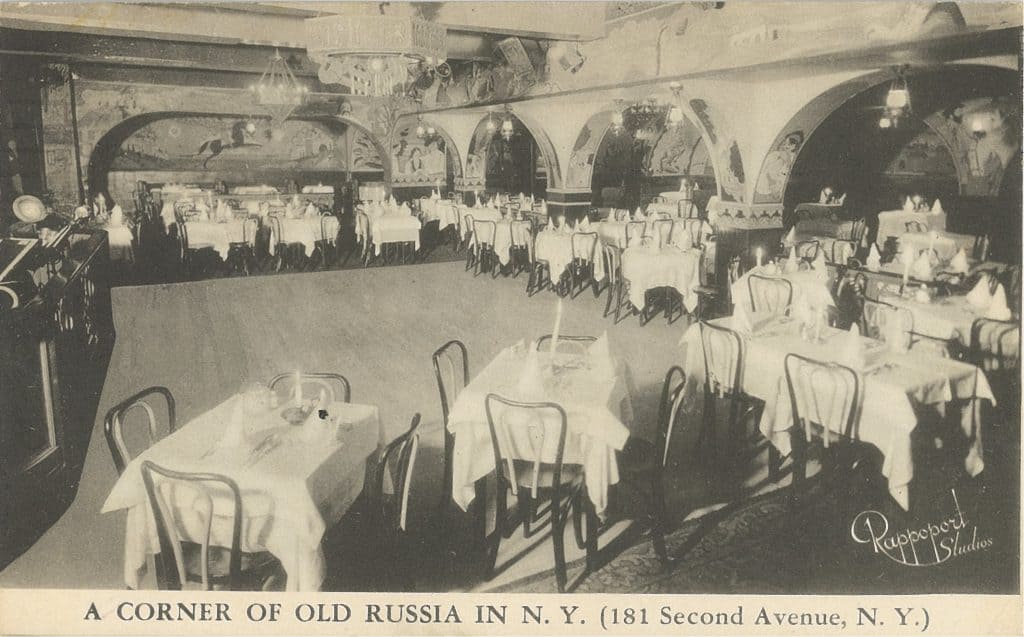
Most of that period’s shows were heavy on nostalgic sentiment and new world solidarity but Maurice Schwartz the Yiddish Art Theatre’s creative leader reached for something deeper, educated by psychological insights and social “folk” realism. The formula was not one that guaranteed financial success so Russian-born attorney Louis N. Jaffe, who commissioned Ohio architect Harrison G. Wiseman to construct the Moorish Revival landmark, encouraged the building to incorporate spaces for allied and related businesses. The downstairs restaurant space emerged out of this process.
Elaborate interior details made the theater a contender among the new movie palaces and legitimate theaters going up all over New York. Unfortunately, amity between the artist and developer was not enduring. Consequently, the theater went through a succession of ownership and branding changes. By the mid-1940s, it stopped operating as a Yiddish Theater. The below ground restaurant space was taken over by the Gambino crime family and turned into Club 181, described by one observer as the “homosexual Copacabana.”
The nightclub closed at that location in 1953 and moved just a few blocks away and became the notorious drag emporium Club 82, also under the Gambinos’ patronage. The theater did not lose its creative and outré image. During the 1950s as the Phoenix, it showcased serious drama with emerging stars. In the early 60s, the theater hosted Ann Corio’s This Was Burlesque and later premiered the nude review Oh! Calcutta! before that show moved to Broadway. Today the theater marches on as a showcase for serious art films.
Nearby also on the Lower East Side the Russian Kretchma (meaning “inn”) at 244 East 14th Street eventually changed its moniker to the Two Guitars Nightclub. Like its downtown competitor, the nightclub promised “Four shows nightly” and delivered sing-along versions of nostalgic folk songs to its primarily Russian-Jewish clientele. Lubov Hamshay, Marina Federova, Alya Unov, and Olga Karpis were among the glamorous stars who performed at the club. Unfortunately, their sphere of influence did not extend far beyond this specialized audience segment of recent immigrants.
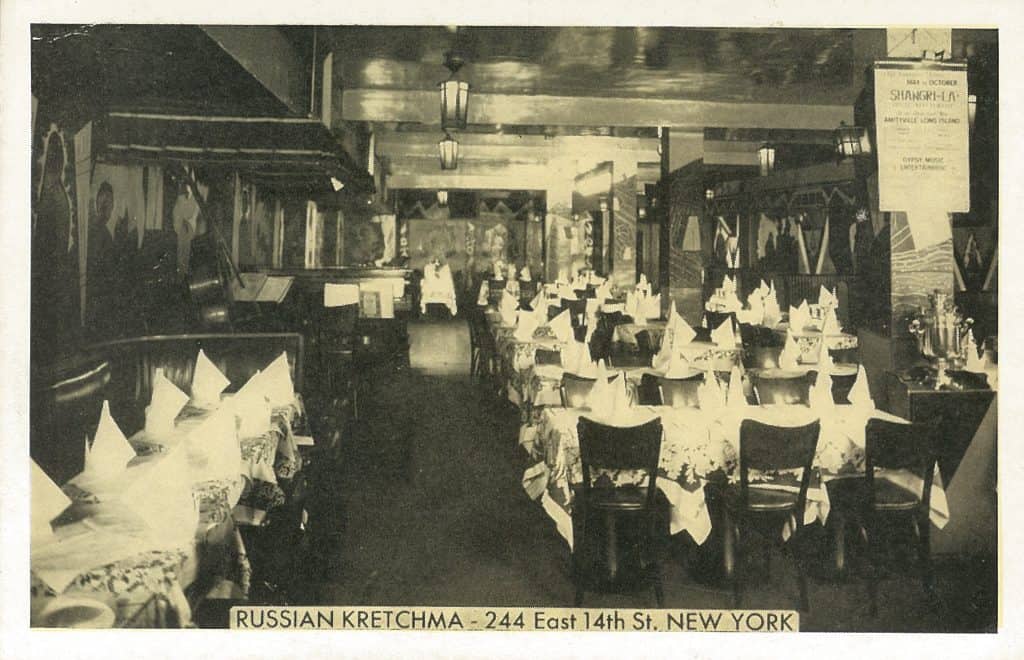
Midtown Manhattan East and West was where most of New York’s classic Russian restaurants were located. The claim to being the oldest goes to the Russian Bear – also sometimes called the Old Russian Bear or Tarwid’s Russian Bear which traces its heritage to 1909. This is the date that the eatery was established in St. Petersburg, Russia, but its New York appearance is likely in the mid-1920s after the patriarch of this Latvian-Russian family Mieczyslaw Gaspard Tarwid immigrated to New York City. Multiple attractive postcards published by the Russian Bear recall folk legends and Russian ethnography and trace moves of the restaurant between 645 Lexington Avenue and 139 E. 56th Street. Lonya Kalbouss and his Gypsy Orchestra are listed as the principal entertainers. The restaurant closed with the owner’s death in 1984.

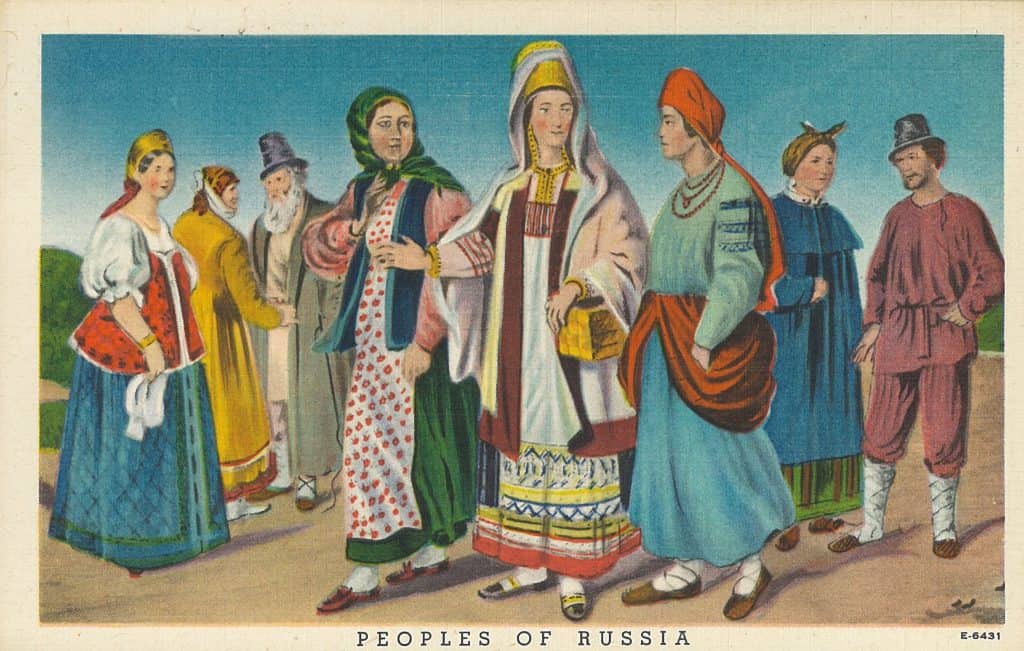
Across town in the Theater District the Russian Skazka operated during the 40s and 50s at 227 West 46th Street. As most New Yorkers know, this street between 6th and 9th Avenues is occupied by “Restaurant Row” where a bewildering array of cuisines continues to be offered to theatergoers for some pre- and post-show indulgence. A piano and Balalaika (Russian stringed instrument) in this attractive linen postcard suggest that the conviviality went on quite late. The menu, even coming during the war years, offers a full lineup of Russian specialties and the top item on its Vodka drinks list is their “Molotov Cocktail” for $1.00 which they promise is “stronger than the Zombies.” The limit is one per customer, whether or not the Zombies are vanquished.
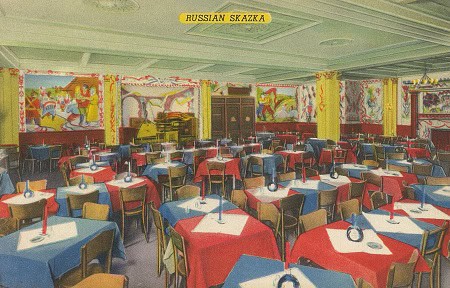
Manhattan’s Upper 50s, an area dominated by concert stage Carnegie Hall and many associated music businesses appears to be the area where most of New York’s Russian restaurants and nightclubs congregated. Just west of Fifth Avenue, The Russian Inn at 33 West 57th Street occupied one of three residential brownstones turned into commercial buildings. Originally owned by Rothschild family interests, many New Yorkers recall one of these as the outpost of the Rizzoli Bookstore, noted for large format art books. Except for the beautiful card below featuring a “decoration” by Boris Artzybasheff, very little is recorded or recalled about this c. 1950s establishment in an area now known as “Billionaire’s Row,” is sorely missed by many who indulged afternoons deep into its extensive repertory of photography books.
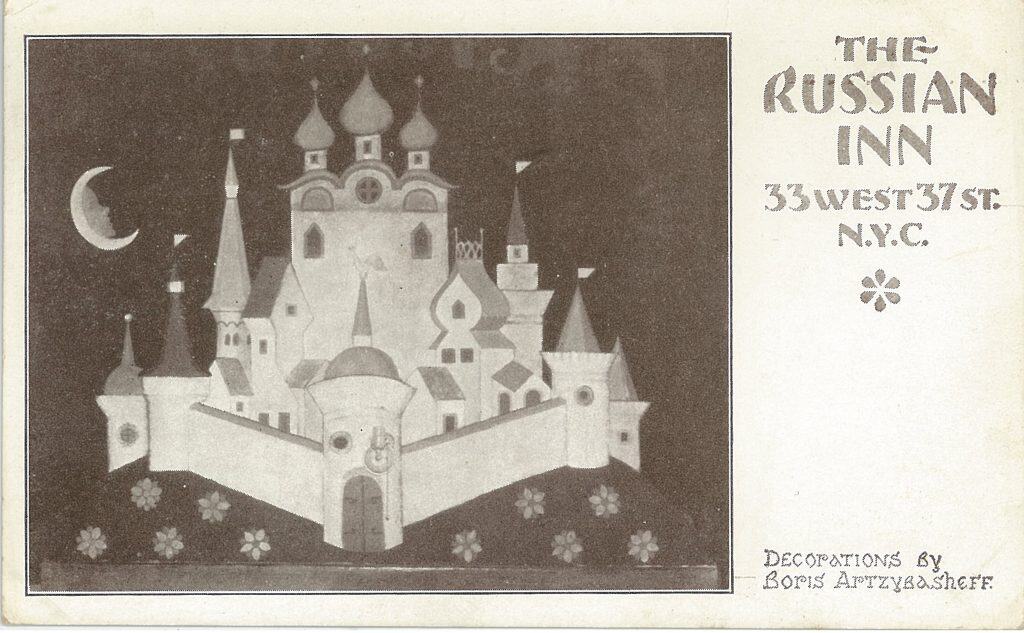
Just a few blocks away on a street normally associated with jazz and striptease clubs, The Russian Yar Restaurant at 38 West 52nd promoted nightly performances by its “Famous Dagger Dancer” Zachar Martinoff. His postcard suggests he would make great company for a nighttime walk around the city nowadays. The name “Yar” (Restaurant) recalls a 19th Century Moscow boîte where intellectuals like Pushkin, Tolstoy, Chekhov, and Maxim Gorky shared ideas and vodka. Nobody is sure what kind of poetry came out of New York’s Yar.
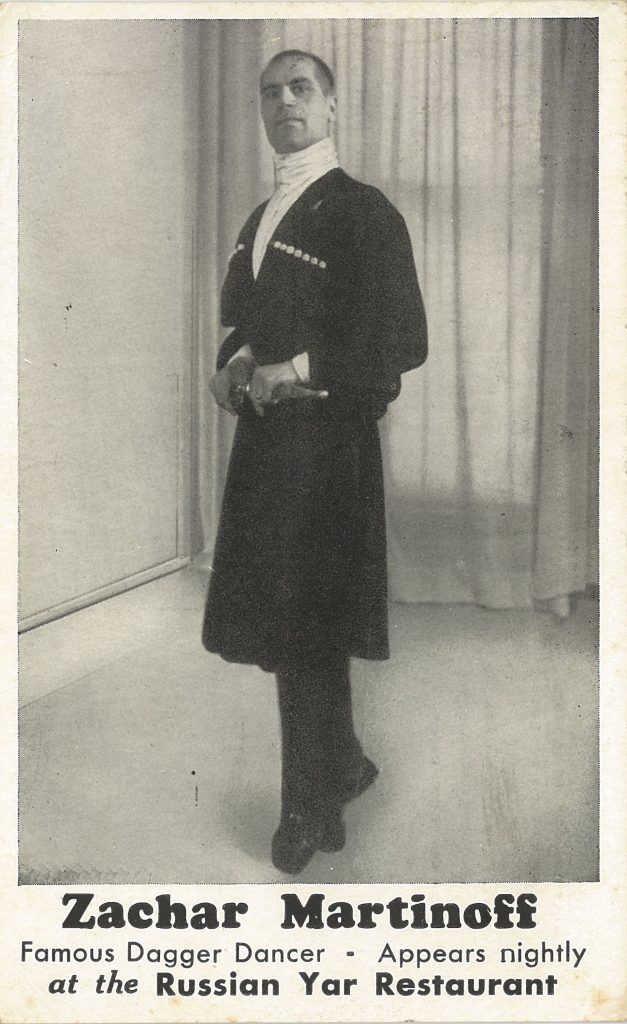
Two wonderful postcards from the 1940s-50s-60s share the same address though their restaurants are branded differently. One-fifty-seven West 56th Street places the restaurants on the back side of the Carnegie Hall building. It would appear that one succeeded the other, however, documentary evidence is difficult to obtain. The Balalaika Restaurant uses the imagery of the triangular stringed instrument of that name framed by red and blue hands – It’s one of the most beautiful and dramatic restaurant ad cards in the entire hobby.
Competing for drama is this image of a flame dancer from The Casino Russe. Copy on the verso of this Lumitone Photoprint promises that the restaurant was air conditioned. It’s clear who needed this the most. The paying guests could count on authentic atmosphere, a floor show, dinner, drinks and dancing.
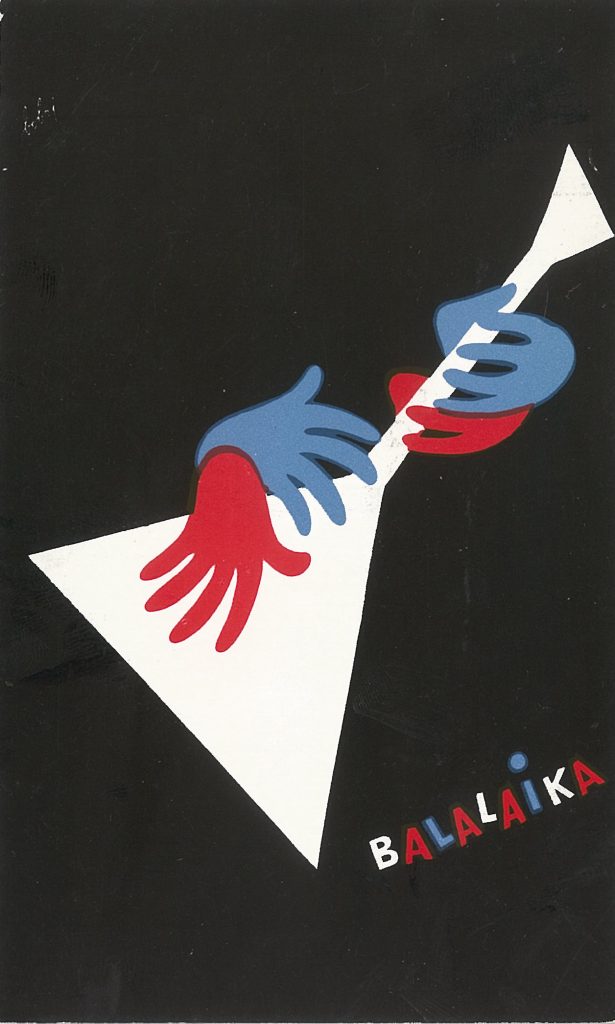
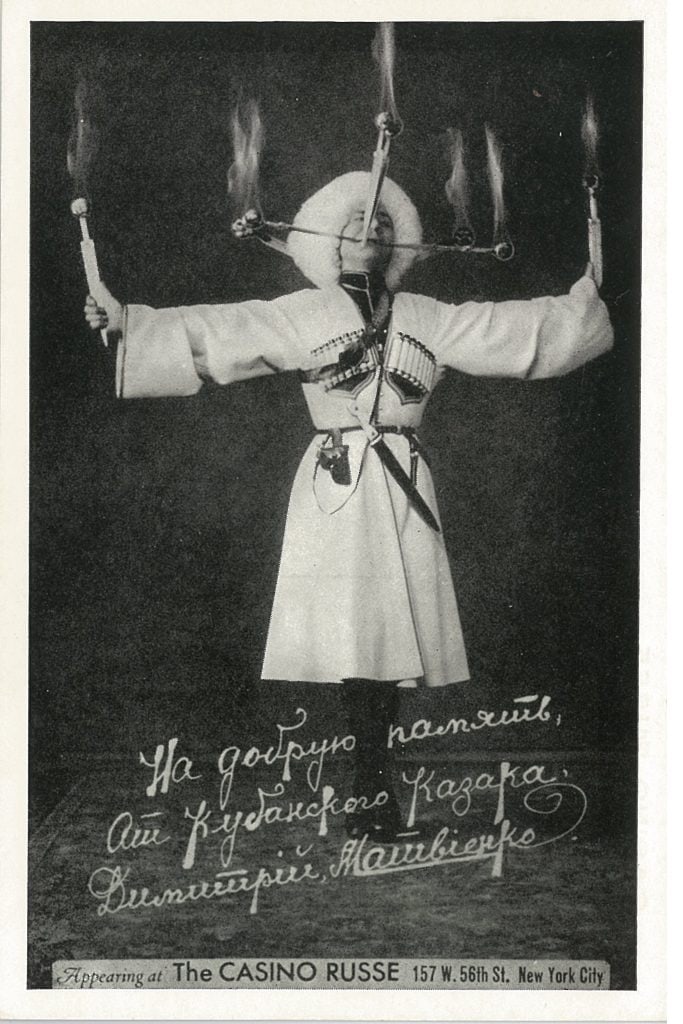
Around the corner at 150 West 57th Street – the front end of the Carnegie Hall building – sits the doyenne of New York’s Russian nightspots, the famed Russian Tea Room. Founded in 1927 by Russian Imperial Ballet members as a place where fellow expat artists could pick up homey snacks. By the 1950s and 60s, the Russian Tea Room had become a prominent celebrity hangout, ideal for a celebratory meal especially if you were celebrating your premiere at Carnegie Hall. You could stop by for a drink and see Rudolf Nureyev at one end of the bar and Lauren Bacall at the other. Madonna worked as a coat-checker here while she was climbing the ladder of fame.
Frequent closures, changes of ownership, renovations, and restagings, especially since the 1990s have tarnished the Russian Tea Room’s image. Nowadays, it’s one of those old-time New York classics that locals love to hate because its past and their memories outpace the current reality. Fortunately for us, the Tea Room was a prolific publisher of promotional postcards that can give us a sense of the style and verve of its salad days. The oldest postcard from the 30s shows the Tea Room’s classic art deco streamlined bar. Next, the Boyar Room, an events space features their music and dance-themed murals.
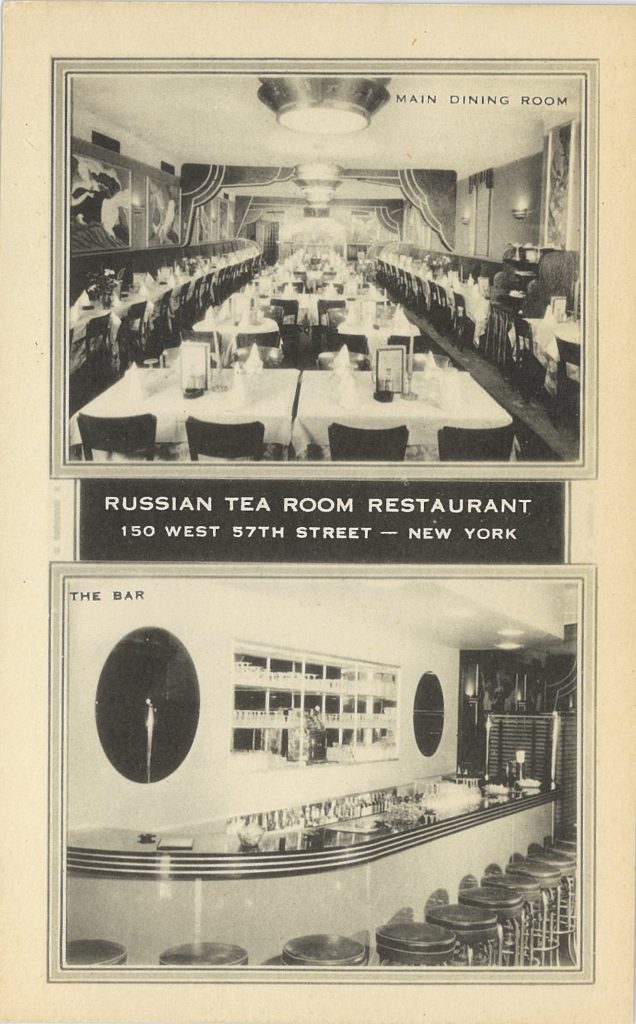
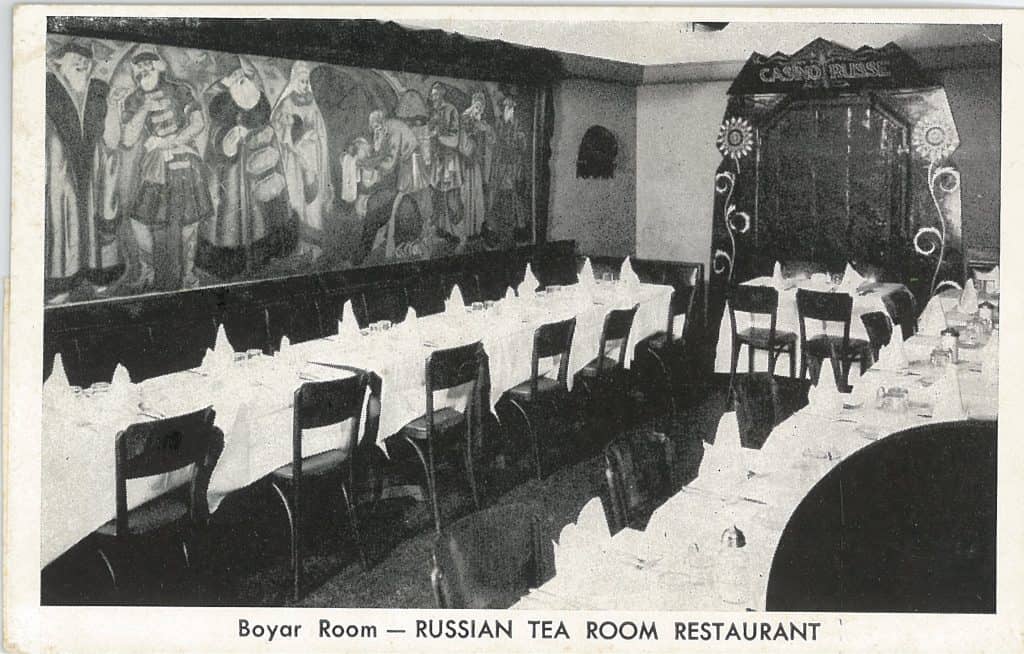
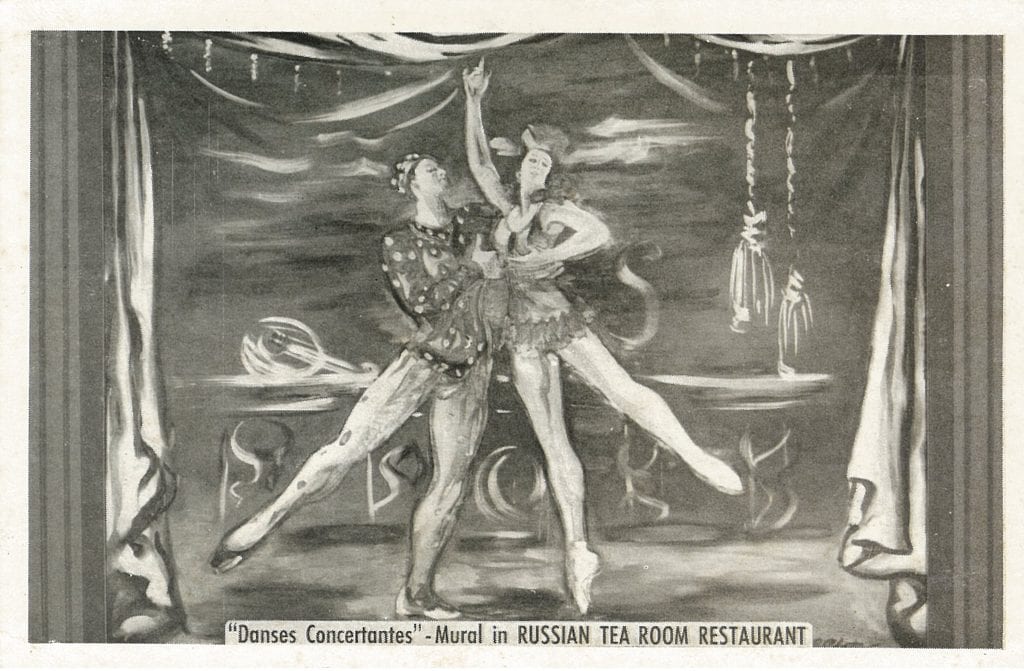
To show that they’re up to date for 50s-60s style humor, The Russian Tea Room published a collection of cartoon caricatures illustrating typical customers of their meals and drinks. They didn’t slow down for a minute as indicated by this 1980s Russian costume parody signed by master graphic designer Milton Glaser, known to many New Yorkers as the creator of the “I Love [heart] New York” logo.
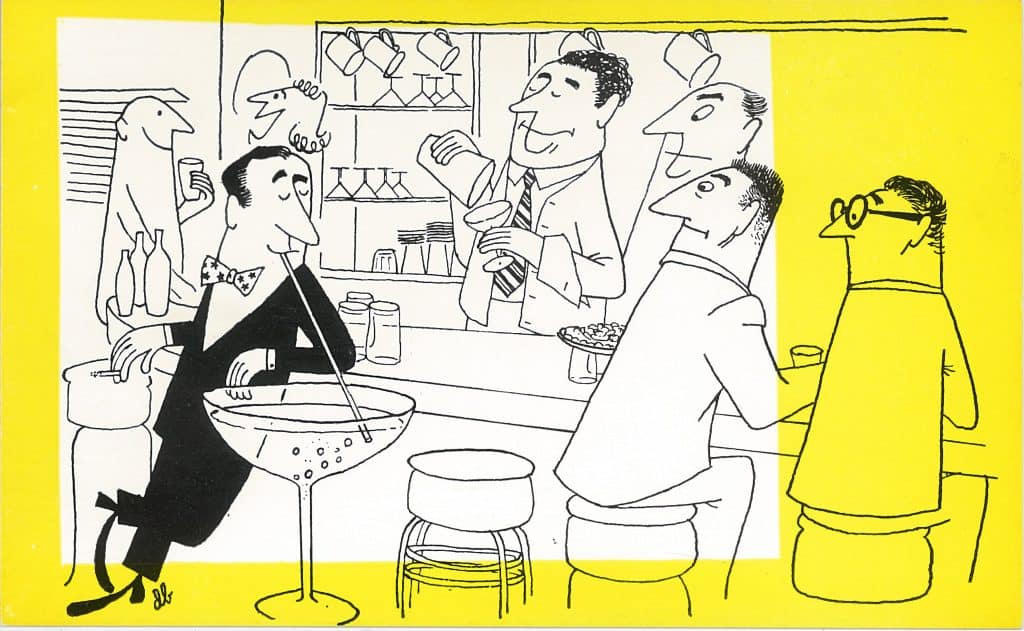
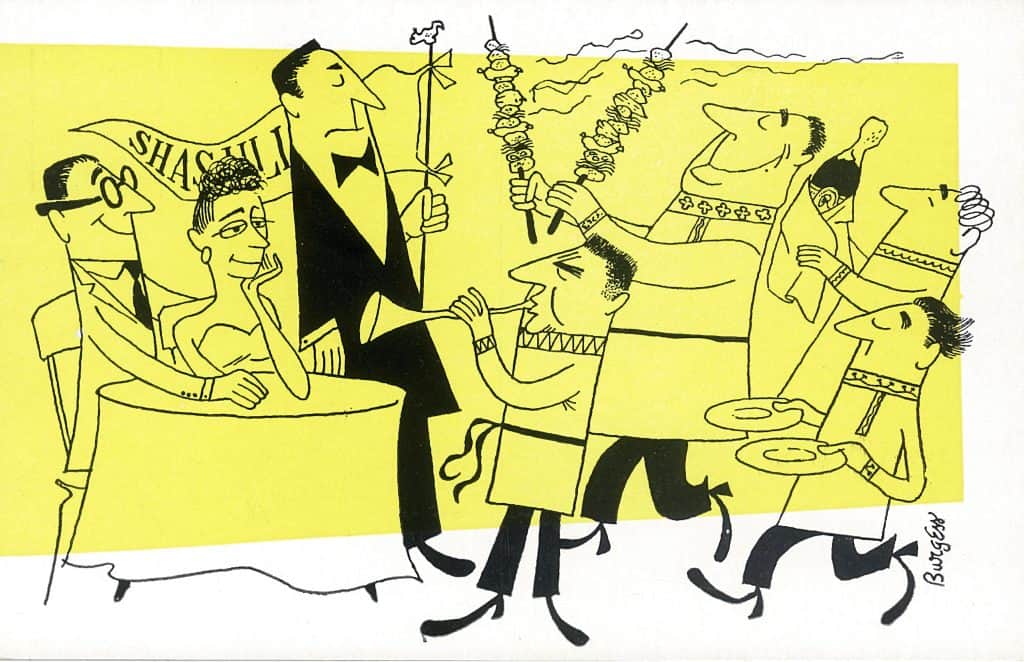
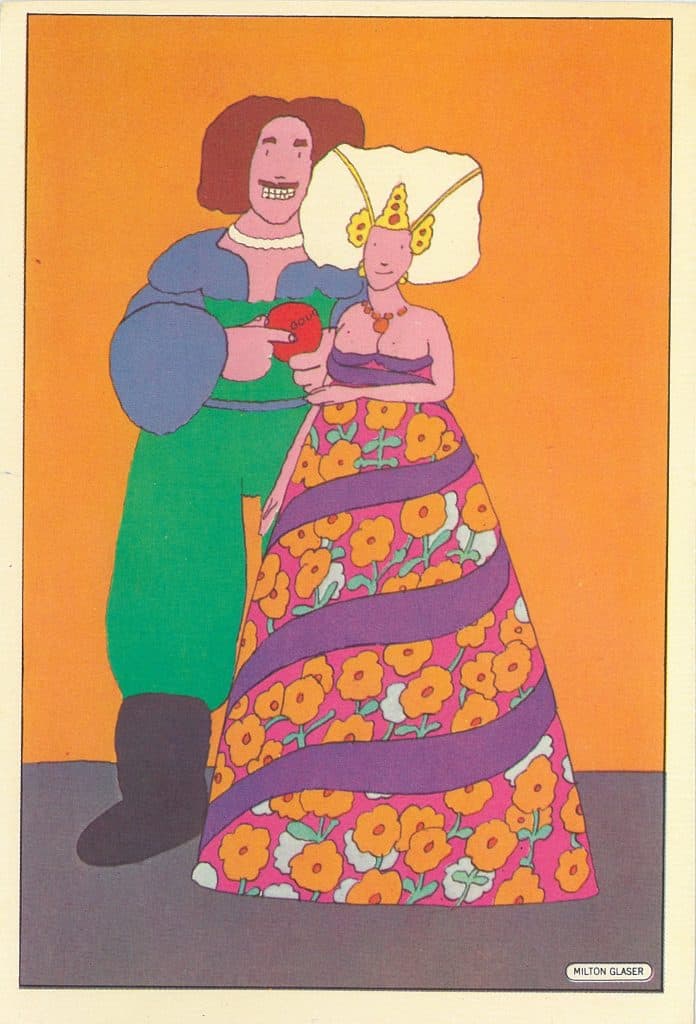
If all this Russian talk has gotten your appetite whetted for a tasty caviar snack, rest assured that you can get a nice portion of Beluga for $325 an ounce today at the Russian Tea Room. It’s a great way to celebrate when your novel hits #1 on the New York Times “Best Seller” list. Wash it down with some refreshments from what they claim is New York’s best vodka selection. Za Zdorovye!
A+++++++++++
I remember a scene from the Woody Allen film Manhattan taking place at the Russian Tea Room.
The Chicken Kiev was delicious.
All that you have learned about and shared with us here, thank you very much. And a special thank you for remembering and acknowledging our long time friends, Janet and Lew Baer. I love her postcards, and my memories of her sketching whenever she sat down. The sketch book was always in her purse. I so thank you.
Wonderful article. Even when you don’t collect in an area you can see right away when the cards are really special and uncommon, as is the case here.
Many thanks Hy. Janet would have shrieked with delight at your article. She loved the ЯTR and had quite a few cards from there, but I have more. On my visits for the Metro show I would dart in and snag a few cards from the tray by the hatcheck. Now I wish I had asked for an autograph. I’ll debate the meaning of Yar with you which I learned to mean gulley or ravine. Bravo and большой спасиба!
So glad you think Janet would have liked “her” article. Of course I remember ducking into the RTR and many other restaurants and shows together with you because you were staying at my old Brooklyn place during the Metro shows during the ’90s. I agree that “restaurant” is not a very good translation for “yar” but I can see how “the hole” is a great affectionate name for a memorable hangout. Gee, it must have been a fabulous place to hang out when you think of the crowd.
Thanks, again, for wonderful info energized with postcard visuals. You’re a treasure.